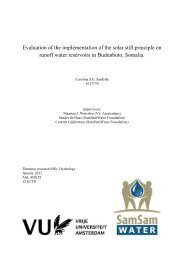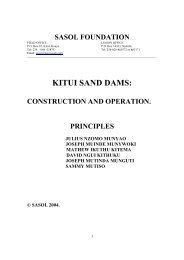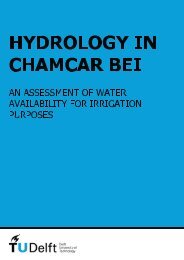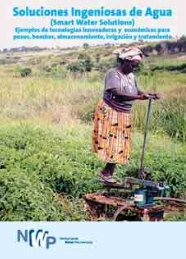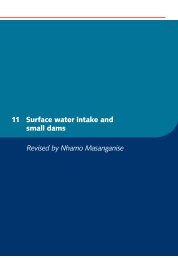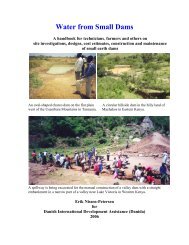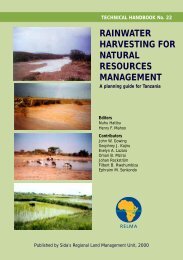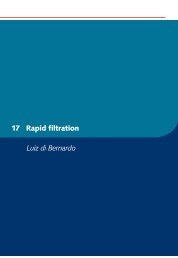Hydrogeology and siting of micro-dams around Léo Burkina Faso
Hydrogeology and siting of micro-dams around Léo ... - SamSamWater
Hydrogeology and siting of micro-dams around Léo ... - SamSamWater
Create successful ePaper yourself
Turn your PDF publications into a flip-book with our unique Google optimized e-Paper software.
<strong>Hydrogeology</strong> <strong>and</strong> <strong>siting</strong> <strong>of</strong> <strong>micro</strong>-<strong>dams</strong> <strong>around</strong> <strong>Léo</strong>, <strong>Burkina</strong> <strong>Faso</strong>14 June 2010Signs <strong>of</strong> erosion (gullies) are visible on both sides <strong>of</strong> the dam. During the rainy season the water levelgets so high that water flows over <strong>and</strong> <strong>around</strong> the dam (not only the spillway) damaging the dam <strong>and</strong>creating erosion gullies. These problems were discussed with Henk Haas <strong>and</strong> Huib Povel <strong>and</strong> plans arecurrently being made to fix these problems.The soil in the riverbed consists <strong>of</strong> clay on top <strong>of</strong> laterite. At some locations the laterite has a highs<strong>and</strong> content making the scoopholes collapse.The surface water reservoir is intensely used by people fetching water in barrels for brick making,washing clothes <strong>and</strong> cattle. On the riverbanks <strong>around</strong> the dam are many agricultural plots located. In<strong>and</strong> <strong>around</strong> these agricultural plots there are several scoopholes. Some <strong>of</strong> them were dry at the time<strong>of</strong> visit, but most <strong>of</strong> them contained water (generally a few meters deep).Further away from the dam (200 – 300 m on the riverbanks) are a number <strong>of</strong> old open h<strong>and</strong>dug wells.They are only used if the shallow wells/scoopholes near the dam dry up.Drinking water is currently being fetched from boreholes <strong>and</strong> a number <strong>of</strong> water points in the village.The water from the shallow wells/scoopholes near the dam is only used for irrigation.3.4 TabouThe <strong>micro</strong>-dam <strong>of</strong> Tabou (or Timbo as indicated on some maps) is located about 29 km North <strong>of</strong> <strong>Léo</strong>.Construction works on the dam took place between November 2008 <strong>and</strong> March 2009. Due to politicalproblems the work is not finished yet. CREDO hopes to restart the constructions soon. More details onthe dimensions <strong>and</strong> construction can be found in “Description du barrage de Tabou, révisé” (HenkHaas, 2008). The catchment area <strong>of</strong> this dam has a surface area <strong>of</strong> 564 km 2 .Figure 10 Overview <strong>of</strong> the Tabou dam siteAt the time <strong>of</strong> visit there was some surface water present in a number <strong>of</strong> small natural depressions inthe riverbed.On the riverbanks near the dam are a number <strong>of</strong> agricultural plots located. People fetch water fromscoopholes <strong>and</strong> shallow wells for irrigation. Normally water is fetched by lowering a bowl or bucketwith a rope, but at one (larger) scoophole a motor pump was present. According to the owner, thewater level drops quickly if he uses this pump, but after about 2 hours the water has risen again to it’soriginal level.The soil <strong>around</strong> the riverbed consists <strong>of</strong> clay on top <strong>of</strong> laterite.Since the construction <strong>of</strong> this dam was already decided, but not yet finished, the site is notrepresentative for a location with a <strong>micro</strong>-dam, nor for a location without a <strong>micro</strong>-dam, so no furthermeasurements were done at this site.10




